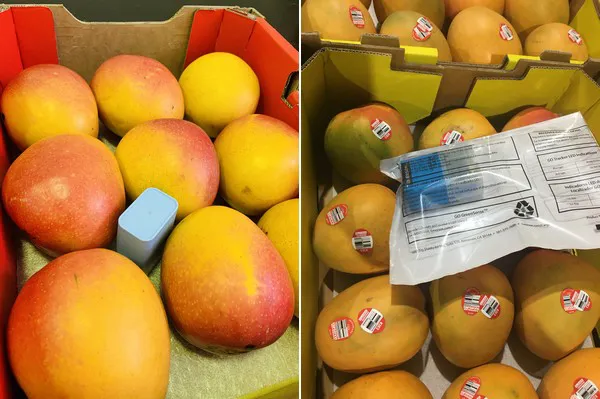Having mangoes arrive in export markets at the right quality and ripeness can mean the difference between exporters making a profit or loss, and good temperature management is the key. Real-time monitoring of temperature, particularly in road and air-freighted fruit using wireless/autonomous reporting loggers, gives the potential to identify, quantify and manage risks before they affect quality and profits.
Thirteen businesses responsible for at least 69% of 2020/21 mango exports said they monitored their cool chains last season using real-time data loggers. This information was collected by Noel Ainsworth and John Agnew from the Department of Agriculture and Fisheries (DAF) as part of the “Serviced Supply Chains” end of project survey.
In 2016, before the start of the project, no one used real-time loggers. Most exporters put USB manual download loggers in shipments only in case of claims. They were rarely retrieved and almost never used to monitor or manage the cool chain.

In a 2017 survey there was considerable variation in exporters skills to access and use supply chain temperature data, with over 40% rated between “not knowing anything” to being “OK.” Speaking with some of those same exporters today, it is clear that these skills have improved dramatically, ranging from “satisfactory” to “very good” levels. This is doubly impressive because the technology being used today is more varied and sophisticated, versus only dealing with USB loggers.
“Revealing what happens in the chain” was the main benefit of temperature monitoring, nominated by the majority of respondents to the 2021 survey.
Exporters were asked to give an example of where temperature monitoring was used to make an improvement in their supply chain. Some of the responses included:
- “Mangoes were not cooled sufficiently at the packhouse prior to transport and addressing this made the rest of the supply chain easier to manage.”
- “Monitoring in transit allowed ripening plan decisions to be made once produce arrived at destination.”
- “Monitoring of the whole chain pin-pointed the place where temperature deviation occurred and enabled correction.”
- “Identified the need for improved forced-air cooling at the VHT facility.”
- “Discovered that freight forwarders were holding fruit at higher temperatures than requested. Once they were made aware, things improved quickly.”
- “Export shipments to the same destination were consistently arriving hot and spoiled. Placing real-time loggers in the shipments identified exactly where the problem was and enabled us to fix it.”
- “A fumigator in country was heating the fruit up too high during treatment and then storing it too cold (8˚C).”
- “Gained knowledge about impact of higher than optimum transport temperature on ripening and flavour characteristics.”
Two of the exporters who were originally surveyed in 2017 were asked how their temperature management experience had changed compared to today? Regarding barriers, the original major issue was retrieving USB loggers to get data. Today the barriers included cost of real-time SIM loggers (particularly if monitoring most shipments) and difficulty accessing real-time data because of connectivity issues. These exporters said that the main gain from temperature monitoring in 2017 was reduction in some claims, but today the benefits amounted to: fewer temperature fluctuations, potential to intervene when temperature excursions occur, fewer and smaller sized claims and improved product quality. When asked if they realised a monetary benefit from temperature monitoring in 20/21, they quoted $100,000 and $50,000 respectively.
According to the survey results, project information and activities had a significant influence on temperature monitoring/management by mango exporters. The two highest and equally ranked responses to the question about the project’s influence were “viewing temperature data” and “identifying cool chain problems”.
While real-time temperature monitoring has only become possible in the last few years with the availability of SIM based loggers, it is now commonplace in the Australian mango industry. Exporters also understand that sharing monitoring results with supply chain partners builds a stronger relationship and leads to better cooperation. This goes a long way towards improving fruit quality, value and profits.
The Serviced Supply Chains project was funded by the Hort Frontiers Asian Markets Fund (project AM15002), part of the Hort Frontiers strategic partnership initiative developed by Hort Innovation, with co-investment from the Department of Agriculture and Fisheries (Queensland), Department of Jobs, Precincts and Regions (Victoria), Manbulloo (mangoes), Montague Fresh (summerfruit), Glen Grove (citrus) and the Australian Government.
For more information:
John Agnew
Tel: +61 436 849 357
Email: [email protected]
